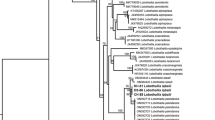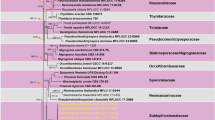Abstract
We examined the taxonomic position of Leptosphaerulina japonica, a parasitic fungus on male strobili of Japanese cedar (Cryptomeria japonica) using morphology and molecular phylogeny. Because neither specimens nor illustrations were designated in the original paper, this name is neotypified with a fresh specimen collected from the type locality, Yamagata, Japan. Leptosphaerulina japonica has asci produced in a broad layer arising from the entire base of the locule, stipitate acervuli, and a hormonema-like synanamorph. These characteristics are not typical of the genus Leptosphaerulina (Didymellaceae, Pleosporales). In a molecular phylogenetic analysis of ITS sequences, L. japonica was placed into the Dothideaceae/Dothioraceae, Dothideales. Although muriform ascospores and an anamorph with long stipitate acervuli have not been reported for species in Sydowia, the other morphology and phylogeny support placement of L. japonica in that genus. Thus, a new combination, Sydowia japonica, is proposed.




Similar content being viewed by others
References
Barr ME (1972) Preliminary studies on the Dothideales in temperate North America. Contr Univ Mich Herbarium 9:523–638
Barr ME (2001) Revisionary studies on the Dothioraceae. Harv Pap Bot 6:25–34
Bills GF, Collado J, Ruibal C, Peláez F, Platas G (2004) Hormonema carpetanum sp. nov., a new lineage of dothideaceous black yeasts from Spain. Stud Mycol 50:149–157
Brefeld O, Tavel RF von (1891) Untersuchungen aus dem Gesammtgebiete der Mykologie 10: 269
Butin H, Pehl L (1993) Kabatina abietis sp. nov., associated with browning of fir needles. Mycol Res 97:1340–1342
Butin H, Schneider R (1976) Kabatina populi nov. spec. Phytopathol Z 85:39–42
Cheewangkoon R, Groenewald JZ, Summerell BA, Hyde KD (2009) Myrtaceae, a cache of fungal biodiversity. Persoonia 23:55–85
Crous PW, Gams W, Stalpers JA, Robert V, Stegehuis G (2004) Mycobank: an online initiative to launch mycology into the 21st century. Stud Mycol 50:19–22
de Hoog GS, Hermanides-Nijhof EJ (1977) Survey of black yeasts and allied fungi. Stud Mycol 15:178–221
Denison WC, Carlstrom RC (1968) Ascocarp development in Leptosphaerulina argentinensis. J Mitchell Soc XX:254–257
Dugan FM (2006) The identification of Fungi: An illustrated introduction with keys, glossary and guide to literature. APS Press, St Paul, Minnesota
Eriksson O (1981) The families of bitunicate ascomycetes. Oper Bot 60:1–220
Farr DF, Rossman AY (2012) Fungal databases, systematic mycology and microbiology laboratory, ARS, USDA. http://nt.ars-grin.gov/fungaldatabases/. Accessed 9 Feb 2012
Graham JH, Luttrell ES (1961) Species of Leptosphaerulina on forage plants. Phytopathol 51:680–693
Grove WB (1912) New or noteworthy fungi – part IV. J Bot L 50:44–55
Gruyter J de, Aveskamp MM, Woudenberg JHC, Verkley GJM, Groenewald JZ, Crous PW (2009) Molecular phylogeny of Phoma and allied anamorph genera: towards a reclassification of the Phoma complex. Mycol Res 113:508–509
Hawksworth DL (2011) A new dawn for the naming of fungi: impacts of decisions made in Melbourne in July 2011 on the future publication and regulation of fungal names. Mycokeys 1:7–20
Hermanides-Nijhof EJ (1977) Aureobasidium and allied genera. Stud Mycol 15:141–177
Huelsenbeck JP, Ronquist F, Nielsen ES, Bollback JP (2001) Bayesian inference of phylogeny and its impact on evolutionary biology. Science 294:2310–2314
Huelsenbeck JP, Larget B, Miller RE, Ronquist F (2002) Potential applications and pitfalls of Bayesian inference of phylogeny. Syst Biol 51:673–688
Hyde KD, McKenzie EHC, KoKO TW (2011) Towards incorporating anamorphic fungi in a natural classification – checklist and notes for 2010. Mycosphere 2:1–88
Inderbitzin P, Gareth Jones EB, Vrijmoed LP (2000) A new species of Leptosphaerulina from decaying mangrove wood from Hong Kong. Mycoscience 41:233–237
Ito K, Shibukawa K, Kobayashi T (1952) Etiological and pathological studies on the needle blight of Cryptomeria japonica 1. Morphology and pathogenicity of the fungi inhabiting the blighted needles. Bull Gov For Exp Sta (Tokyo) 52:79–152 (In Japanese)
Kasai M (1917) Sclerotia disease on seedlings of Japanese cedar and black spot disease on Japanese cedar. J Plant Prot 4:23–28, Japanese title were translated in English by authors
Katoh T (2008) Recent developments in the MAFFT multiple sequence alignment program. Brief Bioinform 9:286–298
Kobayashi T (1970) Notes on new or little-known fungi inhabiting woody plants in Japan II. Trans Mycol Soc Jpn 11:57–63
Kornerup A, Wanscher JH (1978) Methuen handbook of colour, 3rd edn. Methuen, London
Luttrell ES (1951) Taxonomy of the Pyrenomycetes. Univ Mo Stud 24:1–120
Luttrell ES (1960) The morphology of an undescribed species of Dothiora. Mycologia 52:64–79
Maddison WP, Maddison DR (2010) Mesquite: a modular system for evolutionary analysis. version 2.74. http://mesquiteproject.org
Mason-Gamer RJ, Kellogg EA (1996) Testing for phylogenetic conflict among molecular data sets in the tribe Triticeae (Gramineae). Syst Biol 45:524–545
McNeill J, Turland NJ, Monro A, Lepschi BJ (2011) XVIII International Botanical Congress: preliminary mail vote and report of Congress action on nomenclature proposals. Taxon 60:1507–1520
Müller E (1953) Über Dothidea polyspora Berf. et v.Tav. und die Gattung Sydowia Bres. Sydowia 7:340–342
Nirenberg HI (1976) Untersuchungen über die morphologische und biologische Differenzierung in der Fusarium-Sektion Liseola. Mitteilungen aus der Biologischen Bundesanstalt für Land- und Forstwirtschaft 169:I–v + 1–117
Norvell LL (2011) Fungal nomenclature. 1. Melbourne approves a new Code. Mycotaxon 116:481–490
Posada D (2008) jModelTest:Phylogenetic model averaging. http://darwin.uvigo.es/
Reeb V, Lutzoni F, Roux C (2004) Contribution of RPB2 to multilocus phylogenetic studies of the euascomycetes (Pezizomycotina, Fungi) with special emphasis on lichen-forming Acarosporaceae and evolution of polyspory. Mol Phyl Evol 32:1036–1060
Roux C (1986) Leptosphaerulina chartarum sp. nov., the teleomorph of Pothomyces chartarum. Trans Br Mycol Soc 86:319–323
Saccardo PA (1889) Sylloge Fungorum hucusque congnitorum vol. VII. Padova
Sawada K (1950) Fungi inhabiting on conifers in the Tohoku district. 1. Fungi on “Sugi”(Cryptomeria japonica D. Don.). Bull Gov For Exp Sta (Tokyo) 45:27–53, In Japanese with Latin diagnoses
Schneider R, Von Arx JA (1966) Zwei neue, als Erreger von Zweigsterben nachgewiesene Pilze: Kabatina thujae n. g., n. sp. und K. juniper n. sp. Phytopathol Z 57:176–182
Schoch CL, Crous PW, Groenewald JZS, Boehm EWA, Burgess TI et al (2009) A class-wide phylogenetic assessment of Dothideomycetes. Stud Mycol 64:1–15
Shear CL, Davidson RW (1940) A new species of Dothiora on aspen and willow. Mycologia 32:105–111
Sivanesan A (1984) The bitunicate Ascomycetes and their anamorphs. Vaduz Lichtenstein
Stamatakis A, Hoover P, Rougemont J (2008) A rapid bootstrap algorithm for the RAxML web-servers. Syst Biol 75:758–771
Sutton BC (1980) The Coelomycetes, fungi imperfecti with acervuli, pycnidia and stromata. Commonwealth Mycological Institute, Kew, Richmond
Sutton BC, Waterston JM (1970) Sydowia polyspora. C.M.I. Descr Pathog Fungi Bact 228:1–2, No. 228
Swofford DL (2002) PAUP*. Phylogenetic analysis using parsimony(*and other methods), ver 4.10. Sinauer Associates, Sunderland
Talgø V, Chastagner G, Thomsen IM, Cech T, Riley K, Lange K, Klemsdal SS, Stensvand A (2010) Sydowia polyspora associated with current season needle necrosis (CSNN) on true fir (Abies spp.). Fungal Biol 114:545–554
Tsuneda A, Hambleton S, Currah RS (2004) Morphology and phylogenetic placement of Endoconidioma, a new endoconidial genus from trembling aspen. Mycologia 96:1128–1135
Tsuneda A, Davey ML, Currah RS (2011) A new endoconidial black meristematic genus, Atramixtia, associated with declining white spruce and phylogenetically allied to a lineage of dothidealean conifer pathogens. Botany 89:323–336
Wehmeyer LE (1955) The development of the ascocarp in Pseudoplea gaeumannii. Mycologia 47:163–176
White T, Bruns JTD, Lee S, Taylor J (1990) Amplification and direct sequencing of fungal ribosomal RNA sequences for phylogenetics. In: Innis MA, Gelfand DH, Sninsky JJ, White TJ (eds) PCR Protocols: a guide to methods and applications. Academic Press, San Diego, pp 315–322
Wu M, Hanlin RT (1992) Ascomal development in Leptosphaerulina crassiasca. Mycologia 84:241–252
Zhang Y, Crous PW, Schoch CL, Hyde KD (2012) Pleosporales. Fungal Divers 53:1–221
Acknowledgments
We are grateful to the curator of the herbaria K for loans of L. thujae specimen. We also thank Amy Y. Rossman for numerous discussions and comments on the taxonomy of the genus Dothiora and Sydowia. This study was supported by the MAFF practical technology development project grant No. 22023 “Development on the scattering prevention of cedar and cypress pollen by using fungi”.
Author information
Authors and Affiliations
Corresponding author
Rights and permissions
About this article
Cite this article
Hirooka, Y., Masuya, H., Akiba, M. et al. Sydowia japonica, a new name for Leptosphaerulina japonica based on morphological and molecular data. Mycol Progress 12, 173–183 (2013). https://doi.org/10.1007/s11557-012-0823-0
Received:
Revised:
Accepted:
Published:
Issue Date:
DOI: https://doi.org/10.1007/s11557-012-0823-0




